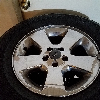2000StreetRod
Moderator Emeritus
- Joined
- May 26, 2009
- Messages
- 10,597
- Reaction score
- 334
- City, State
- Greenville, SC
- Year, Model & Trim Level
- 00 Sport FI, 03 Ltd V8
The Eagle rotating assembly for my 2003 Aviator engine is supposed to ship in a couple weeks. I want to install a motorized pre-oiler before I crank the rebuilt engine installed in my 2003 Limited. There are numerous turbocharger oil scavenge pumps available with a range in cost from $40 to more than $400 but very few 12 volt pumps designed for pressurized pumping. Many of the scavenge pumps specify flow volume at 0 psi but not at pressure (i.e. 20 or 30 psi). I want a pump that has system performance comparable to the Accusump I installed in my 2000 Sport: 20 or more psi at the oil pressure switch port in about 3 seconds after ignition on. A bonus would be enough flow to allow "limp home" on the electric pump if the mechanical oil pump should fail.
I installed the Accusump in my Sport to eliminate the SOHC V6 start up timing chain rattle. Some members may argue that with the advanced synthetic oils available today a pre-oiler is not justified to extend engine bearing life. "However, the spun rod bearings I found when tearing down the Aviator engine convinced me that a pre-oiler may be warranted on the 4.6L V8.


After watching a video showing how much quieter a TurboWerx pump was than the typical $50 to $150 scavenger pump (Turbowerx remote oil pump) I found one on eBay (Exa-Pump TWX-300-12) for $399.

I asked the seller if it was suitable to use as a pre-oiler and the response was: "It will function perfectly for your application. Over the years we have had many customers use our pumps for this as engine pre-oilers with 100% success." Then I searched online for a documented test of success. What I found was quite discouraging: TurboWerx Exa Oil Pump Review - Should you buy one?.
My Accusump has a 3 quart capacity but I think about 1 quart of that is used for stored air pressure. The oil pressure lasts for about 30 seconds before dropping below 5 psi. 2 qts/30 sec so 1 gal/min @ 20 psi should be my minimum flow requirement. RB Racing sells two possibly suitable pumps and their evaluation of their competition is informative: Turbo Electric Oil Feed and Scavenge Pumps

The one on the left is rated for continuous duty at 25 psi and the larger one on the right for 40 psi continuous duty however the flow is not specified at those pressures. The flow at 0 pressure is 2.6 GPM for the smaller pump ($295) and 3 GPM for the larger pump ($430). I'll contact RB Racing and try to get flow rates at pressure. RB Racing points out that if pressure exceeds the rated value the pump will overheat unless protected by an appropriately sized fuse. A pressure relief valve may be needed when pump flow exceeds demand. I suspect that direct drive gear pumps are more susceptible to overheating than other types. I could avoid the need for a pressure relief valve and oil return path by using pulse width modulation (PWM) to control pump speed based on the output voltage of an oil pressure sensor. A PWM motor controller worked well with my 340 lph fuel pump.
I installed the Accusump in my Sport to eliminate the SOHC V6 start up timing chain rattle. Some members may argue that with the advanced synthetic oils available today a pre-oiler is not justified to extend engine bearing life. "However, the spun rod bearings I found when tearing down the Aviator engine convinced me that a pre-oiler may be warranted on the 4.6L V8.
After watching a video showing how much quieter a TurboWerx pump was than the typical $50 to $150 scavenger pump (Turbowerx remote oil pump) I found one on eBay (Exa-Pump TWX-300-12) for $399.
I asked the seller if it was suitable to use as a pre-oiler and the response was: "It will function perfectly for your application. Over the years we have had many customers use our pumps for this as engine pre-oilers with 100% success." Then I searched online for a documented test of success. What I found was quite discouraging: TurboWerx Exa Oil Pump Review - Should you buy one?.
My Accusump has a 3 quart capacity but I think about 1 quart of that is used for stored air pressure. The oil pressure lasts for about 30 seconds before dropping below 5 psi. 2 qts/30 sec so 1 gal/min @ 20 psi should be my minimum flow requirement. RB Racing sells two possibly suitable pumps and their evaluation of their competition is informative: Turbo Electric Oil Feed and Scavenge Pumps
The one on the left is rated for continuous duty at 25 psi and the larger one on the right for 40 psi continuous duty however the flow is not specified at those pressures. The flow at 0 pressure is 2.6 GPM for the smaller pump ($295) and 3 GPM for the larger pump ($430). I'll contact RB Racing and try to get flow rates at pressure. RB Racing points out that if pressure exceeds the rated value the pump will overheat unless protected by an appropriately sized fuse. A pressure relief valve may be needed when pump flow exceeds demand. I suspect that direct drive gear pumps are more susceptible to overheating than other types. I could avoid the need for a pressure relief valve and oil return path by using pulse width modulation (PWM) to control pump speed based on the output voltage of an oil pressure sensor. A PWM motor controller worked well with my 340 lph fuel pump.










